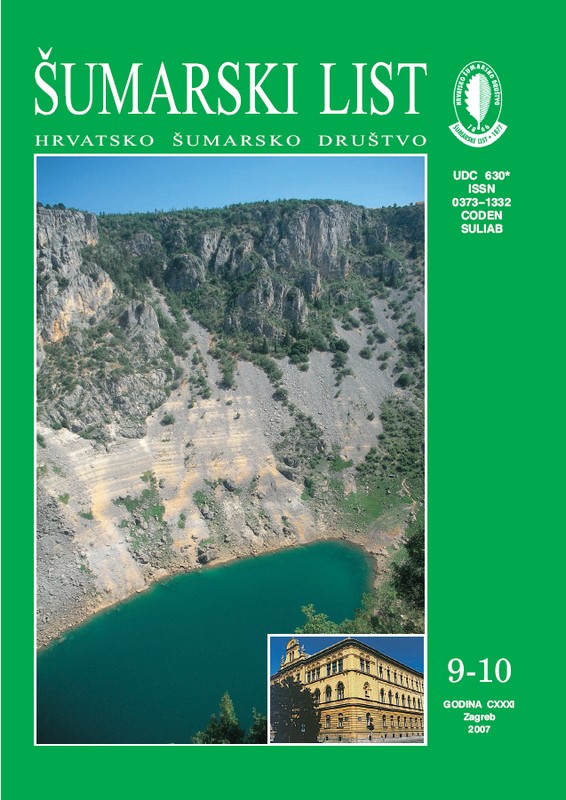
broj: 9-10/2007
pdf (22,5 MB) |
|
||||||||||||||
| RIJEČ GLAVNOGA UREDNIKA | ||
| Branimir Prpić | ||
| Turizam u Hrvatskoj postiže poslije Bljeska i Oluje sve veći uspon, te u gospodarskom razvoju zauzima sve značajnije mjesto. U njegovoj sastavnici, šuma kao infrastrukturna kategorija zauzima značajnu ulogu i to zasigurno puno veću nego što to misle zaduženi za turizam u nas. PDF HR | 406 | |
| IZVORNI ZNANSTVENI ČLANCI | ||
| Vukelić, J., D. Baričević | UDK 630* 188 (001) | |
| Nomenclatural-Syntaxonomic Determination of Pannonian Beech-Fir Forests (Abieti-Fagetum “pannonicum”) in Croatia pdf HR EN | 407 | |
| Trinajstić, I. | UDK 630* 188 (001) | |
| Phytosociological and Syntaxonomic Characteristics of Quercus ilex L. Forests on the Island of Krk pdf HR EN | 431 | |
| Meštrović, Augustin | UDK 630* 231 + 234 (001) | |
| Natural Spreading of the Whitebark Pine (Pinus Heldreichii Christ) and Forming of Pioneer Stands on the Mountan of Čvrsnica in Hercegovina pdf HR EN | 435 | |
| PRETHODNO PRIOPĆENJE | ||
| Pičman, D., I. Rubil, T. Pentek, O. Pičman | UDK 630* 383 + 381 | |
| Soil Stabilisation by Powercem and the Possibility of Implementation in Forest Road Building pdf HR EN | 453 | |
| STRUČNI ČLANCI | ||
| Nikolandić, Đ., D. Degmečić | UDK 630* 156 + 133 | |
| Fertility and Litter Size at Roe Deer (Capreolus Capreolus, L.) in Haljevo Forest pdf HR EN | 465 | |
| Summary: Ecological research of roe deer population was conducted in the forests of Baranja in the period between 1968 and 1972. One research project from that time had the aim to determine fertility of the roe deer population in the Haljevo forest. Usual mating season of roe deer started in the second half of July and ended around the middle of August. Embryo of the impregnated roe deer cannot be seen by the naked eye till the end of December because of temporary standstill in the development of embryo diapause during the period of inactivity, i.e. because of imperceptible cell division in embryo. Because of that, gravidity of roe deer after mating season (July-August) till January was determined by examination of the ovaries of shot roe deer, i.e. by identifying corpora lutea on ovaries or its cross-section. Extraction of ovaries from the uterus of shot roe deer was done during the process of regular kills, from October till the end of January, and during the process of sanitary kills till the beginning of April. Parts of the uterus with ovaries or embryos were extracted on field from every shot female roe deer and put into glass containers with 4 % formalin. The collected material underwent a detail laboratory analysis in the following days and the number of corpora lutea from the left and right apex of the uterus was recorded for every female roe deer. Establishment of roe deer fertility after bringing forth a fawn was conducted from the beginning of May till July 15, twice a week, and after July 15 once in 10 days places of birth were searched for in the hunting-ground, and the new found fawns in the litter, which still cannot follow their mother, were recorded. Adequate places for bringing forth a fawn, such as clearings, parts that are not very dense, young forest cultures and agricultural areas around the forests, lucerne and wheat fields were searched with special care. Through the examination of the uterus and determination of the number of embryos we have established a high degree of fertilization in European roe deer (Capreolus capreolus, L.). In the countries of middle Europe fertilization is at around 90 % in relation to the total number of mature female roe deer. The most intensive growth and development of the embryo, both in length (growth of the skeleton) and in weight (growth in mass) was recorded during April. The intensive growth in April is connected to habitat conditions: air temperature rises, number of sunny hours in a day increases and vegetation becomes the high-quality food for roe deer, because it is easy to digest and rich in proteins. The female chooses the place where she will bring forth and keep its fawn in the first few weeks of its life very carefully. A good roe deer-mother leaves her young in well-hid places with adequate microclimate, which she visits for a short while and very carefully to feed and take care of the young. She goes away only to such distances where she can hear the screams of the fawn if it is in danger. This particular care of the roe deer-mother with highly developed motherly instincts is crucial for survival of fawns in the first weeks of their life. The mortality of the young can also be caused by a very rainy and cold spring, especially with fawns of small birth weight and their poorly developed young mothers as well as with too old roe deer who do not have enough milk or it is of low-quality. The loss of newly born fawns occurs also during mowing of Lucerne fields and grassland around the forest, if we fail to chase out the animals or mark the places of game litter before mowing. During the fawning period (May-June) biggest losses of fawns occur also due to predators: foxes, jackals, wild cats, stray dogs, etc. Key words: Baranja; corpus luteum; diapause; embryo; female roe deer; Haljevo forest; mortality; number of fawns; ovaries; place of birth; planned recruitment; predators; roe deer | ||


